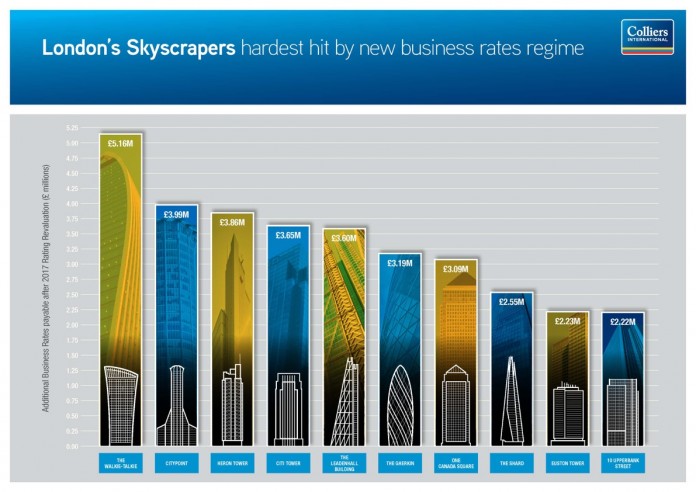Businesses in London’s twenty tallest skyscrapers can expect to pay an extra £50 million under forthcoming major changes to business rates, according to Colliers International, the global commercial real estate agency and consultancy.
In new data analysis published today, Colliers has assessed the likely effects of forthcoming business rates changes – floor-by-floor – on the occupiers of London’s twenty tallest buildings.
Overall, firms will need to cough up an extra £50m as business rates bills go from £194m to £243m over the next three years.
20 Fenchurch Street – dubbed the ‘Walkie Talkie’ and now fully occupied – will see the largest increase with office occupiers and luxury rooftop restaurants faced with a business rates bill of over £19m by 2019, an increase of £5.1m compared with current levels.
Citi Tower – the Canary Wharf home of Citigroup, its sole occupier – will have the largest business rates bill overall at almost £27m.
Whereas, The Shard will see the largest percentage increase at a vertigo-inducing 60 per cent as business rates bills rise from £5m to almost £8m. The current business rates bill for The Shard’s luxury Shangri-La Hotel alone is already almost £1.7m.
Millbank Tower, once headquarters to both the Labour and Conservative parties – is the only top-twenty tallest building expecting a business rates reduction of around £23,000 or one per cent. Office-to-resi development plans at Millbank Tower are not expected to get underway until 2019, at the earliest.
25 Churchill Place – home to accountancy giant EY – sees the smallest rise in real terms. With a £543,000 increase, it will still have the second lowest business rates bill in the top-twenty at £3.7m.
John Webber, Head of Rating, Colliers International, said:
“Local authorities in central London will be delighted at the prospect of an extra £50m in business rates revenue. But for the hundreds of businesses in the Capital’s skyscrapers, the 2017 rating revaluation will bring about the largest changes to business rates in a generation, even taking into account the expected transitional relief. Councils in the rest of the country may well be nervous at the prospect of widespread reductions in business rates income but London can expect a windfall.
“These major rises are a by-product of failed Government policy leading to the erroneous decision to postpone the business rates revaluation leaving a seven-year gap between properties being assessed. Unsurprisingly, with around 300,000 outstanding business rates appeals in the system, this delay has created a culture of appeals. Without clear and direct action, and meaningful reform, these business rates’ bills will be a tall order for London’s skyscrapers.”
The Government is expected to publish the new draft 2017 rating list on 30 September; providing every company with its ‘Rateable Value’. In addition, the agency responsible for business rates – Valuation Office Agency (VOA) – is expected to introduce a revised approach to the valuation process charging more to those businesses towards the top of taller buildings.
Colliers is still campaigning for genuine business rates reform including the need to offer more funding to the Valuation Office Agency (VOA) so it can deal with the estimated 300,000 outstanding business rates appeals in the system.
Colliers Manifesto for Business Rates Reform:
1. More frequent revaluations, three-yearly, at least, by 2022;
2. Increase funding for VOA in order to deal with existing appeals’ backlog;
3. Release VOA from pressure exerted by local councils and HM Treasury;
4. Introduce a register of appeals professionals – removing the ‘cowboy’ element;
5. Iron out inequalities where small business pays a higher proportion in business rates;
6. Root and branch reform of current business rates exemptions and reliefs.






















